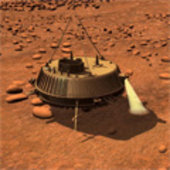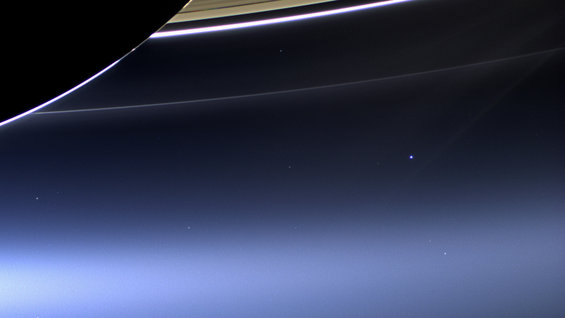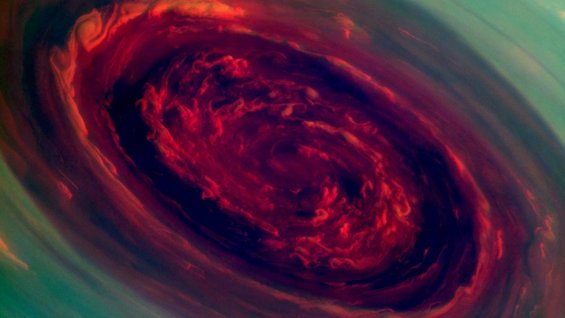
A striking scene in and around Becquerel crater – the largest crater in this view – reveals both the power of wind and water in the turbulent history of Mars. A mound of light-coloured sulphate deposits formed from evaporating water sits inside the crater amid a sea of dark wind-blown deposits. The darker material has blown towards the south-southwest (top left) of the image in a wide swath and across tiny craters there – their raised rims protect the material immediately downwind from being swept away.
The mosaic is composed of four images taken by the High Resolution Stereo Camera on ESA’s Mars Express, with an average ground resolution of 17 m per pixel. The image centre lies at about 22°N/352°E; North is to the right. The individual images were taken on 22 July 2006 (orbit 3253), and 26 February, 2 and 7 March 2008, corresponding to orbits 5332, 5350, and 5368, respectively.
Credits: ESA/DLR/FU Berlin (G. Neukum)
A radiating beauty on Mars
5 September 2013
Exceptional structures deposited and shaped by water and winds adorn these interlocking craters and sculpt radiating patterns in the sands of Mars.
This mosaic, which focuses on Becquerel crater in Arabia Terra, is composed of four images taken by the high-resolution stereo camera on ESA’s Mars Express. Arabia Terra is in the transition zone between the southern highlands and the northern lowlands of Mars.
Becquerel crater is named for the 19th-century French physicist Antoine Henri Becquerel (1852–1908), winner of the Nobel Prize in physics in 1903 along with Marie and Pierre Curie for the discovery of radioactivity.
It is the largest crater in this scene, with a diameter of 167 km, and drops to a depth of about 3.5 km below the surrounding terrain. A second large crater lies within Becquerel, punching even deeper into the surface, as seen in the Mars Express topography and 3D images.
The perspective view below reveals an intriguing, large mound within Becquerel’s crater walls, reminiscent of Mount Sharp in Gale crater, currently being explored by NASA’s Curiosity rover.
The mound rises about 1 km above the crater floor and comprises hundreds of layers of light-toned sediments, each just a few metres thick, made of sulphate-bearing rocks. On Earth, sulphates are most often formed via the evaporation of water, so the presence of these minerals in Becquerel crater suggests that water may once have pooled here in a vast crater lake, before evaporating away.
It is likely that the entire crater floor was once covered with such sediments, but over billions of years much of it has been eroded away by wind, leaving just a polished, rounded mound behind.
Similar light-toned sulphate-bearing deposits are seen all over Arabia Terra, including in the crater walls in this scene, pointing to a large-scale process that affected the entire region.
One popular theory is that large changes in the tilt of the rotational axis of Mars leads to significant changes in its climate, reflected in the thickness and repeating patterns found in the layers of sediment. A change in the environmental conditions would affect the way in which the sediments were initially deposited, as well as their subsequent resistance to erosion.
The deposits were laid down 3.8–3.5 billion years ago, at a time when Mars was evolving from a warm, wet world into the cold and dry planet we see today.
Although water may no longer flow on the Red Planet, wind still plays a key role in shaping the environment. Dark dunes and wind-blown sediments streak through this scene, in vivid contrast to the bright mound.
Rather than having originated locally, the dark material inside Becquerel crater likely blew in from elsewhere – perhaps even from volcanic eruptions.
A dark streak seems to drag the material out from the craters in a wide swath towards the upper left of the main colour image (bottom right of the perspective view above). A number of tiny craters with tail-like structures lie along this track: their raised rims influence the flow of wind over them such that the material immediately downwind of the crater remains undisturbed in comparison to the surrounding, exposed plains.
Another streak of dust follows a radial path out of Becquerel crater; it likely traces out a gentle topographic depression, beyond the eroded rim of the neighbouring old crater.
Meanwhile, dark sediments inside the small crater towards the far left of the main image appear to have been blown out in a similar direction by the powerful prevailing wind.
These blowing sands continue to change the martian landscape even today, exposing ancient rock formations in some locations, while eradicating or covering younger features in others. Detailed studies of these wind-blown patterns can often yield interesting insights into the history of the Red Planet.

Recent Cassini images of the ringed planet and its enigmatic moons
Spectacular close-up view of Saturn’s north-pole hurricane, as seen by the international Cassini spacecraft, revealing the intricate detail of cloud formations in this dynamic feature.
The images were captured by Cassini from a distance of about 419 000 km from Saturn on 27 November 2012, and are the first close-up views of this storm. Image scale is 2 kilometres per pixel.
The images were taken with the Cassini spacecraft narrow-angle camera using a combination of spectral filters sensitive to wavelengths of near-infrared light. The images filtered at 890 nanometres are projected as blue. The images filtered at 728 nanometres are projected as green, and images filtered at 752 nanometres are projected as red. In this scheme, red indicates low clouds and green indicates high ones.
The eye of the hurricane spans about 2000 km and the clouds at the outer edge are travelling at 540 km/h.
The hurricane shares striking similarities to those seen on Earth: both have an eye with no clouds or very low clouds at the centre, high clouds forming an eyewall, with other high clouds spiralling around the eye, and an anticlockwise spin in the northern hemisphere.
Credits: NASA/JPL-Caltech/SSI
ESA > Our Activities > Space Science > Cassini-HuygensLatest News

Cassini sheds light on cosmic particle accelerators18 February 2013

Cassini sheds light on cosmic particle accelerators18 February 2013 During a chance encounter with an unusually strong blast of solar wind arriving at Saturn, the international Cassini spacecraft detected particles being accelerated to ultra-high energies, similar to the acceleration that takes place around supernova...

Cassini spots mini Nile River on Saturn moon12 December 2012

Titan’s seasons make sharp turn28 November 2012

After-effects of Saturn’s super storm shine on25 October 2012

Bouncing on Titan11 October 2012

Bouncing on Titan11 October 2012 ESA’s Huygens probe bounced, slid and wobbled its way to rest in the 10 seconds after touching down on Saturn’s moon, Titan, in January 2005, a new analysis reveals. The findings provide novel insight into the nature of the moon’s surface.
La ESA explica sus descubrimientos en Marte durante la ‘Semana Mundial del Espacio’
4 octubre 2013
Las tecnologías relacionadas con el espacio están tan imbricadas en nuestra vida cotidiana que es fácil olvidar los retos y hazañas que supone la conquista espacial. Rememorarlos y celebrar sus ventajas son los principales objetivos de la Semana Mundial del Espacio, del 4 al 10 de Octubre. La ESA, desde su centro en España, ESAC, contribuirá de forma importante en varias de las actividades, incluyendo tres conferencias divulgativas en Madrid sobre sus misiones Mars Express, Gaia y sobre los grandes programas de la Agencia Espacial Europea para esta década.
En 1999 la Asamblea General de las Naciones Unidas declaró la semana del 04 al 10 octubre de cada año como la Semana Mundial del Espacio. Su propósito es "celebrar cada año a escala internacional las contribuciones de la ciencia y la tecnología espaciales". Hoy este evento se celebra en cerca de 70 países, en planetarios, universidades, escuelas, bibliotecas y organizaciones espaciales. Como referencia, en 2012 se organizaron más de 700 eventos en todo el mundo.
Este año el tema central de la Semana Mundial del Espacio es "Explorando Marte, descubriendo la Tierra". En España se realizarán más de 60 actos entre Barcelona, Madrid, Valladolid, Jaén, y La Rioja. El calendario de actividades puede consultarse en (www.worldspaceweek.es).
La ESA participa con tres conferencias en la Escuela Técnica Superior de Ingenieros Aeronáuticos (ETSIA), en Madrid. El 7 de octubre (18:30 h) Agustín Chicarro, primer Director Científico de la nave Mars Express, de la ESA, explicará los descubrimientos científicos de esta misión en la conferencia “Resultados de Mars Express”. Al día siguiente José Hernández, también de la División de Ciencia de la ESA, pronunciará la charlaGaia, la próxima frontera en Astronomía, sobre esta misión que está a punto de ser lanzada y que generará el mapa tridimensional más preciso de nuestra galaxia jamás elaborado. Finalmente, el 10 de octubre (18:00), Javier Ventura-Traveset, portavoz de la ESA en España, dará una charla sobre los programas presentes y futuros de la Agencia Espacial Europea.
La Semana Mundial del Espacio está organizada a nivel mundial por la Oficina de las Naciones Unidas para Asuntos del Espacio Exterior (UNOOSA), y cuenta con coordinadores nacionales. Armengol Torres, coordinador y colaborador voluntario en España, afirma: "Nuestro objetivo es contribuir a dar a conocer a la población las posibilidades de la ciencia y tecnologías del Espacio directamente de los mejores profesionales del sector”.
Información para Medios de Comunicación
Multimédia

![[1/5] Becquerel Crater](http://www.esa.int/var/esa/storage/images/esa_multimedia/images/2013/09/becquerel_crater/13007490-1-eng-GB/Becquerel_Crater_latestnews.jpg)
![[2/5] Becquerel Crater sulphate mound](http://www.esa.int/var/esa/storage/images/esa_multimedia/images/2013/09/becquerel_crater_sulphate_mound/13007650-1-eng-GB/Becquerel_Crater_sulphate_mound_latestnews.jpg)
![[3/5] Becquerel Crater wind blown sediments](http://www.esa.int/var/esa/storage/images/esa_multimedia/images/2013/09/becquerel_crater_wind_blown_sediments/13007712-1-eng-GB/Becquerel_Crater_wind_blown_sediments_latestnews.jpg)
![[4/5] Becquerel Crater topography](http://www.esa.int/var/esa/storage/images/esa_multimedia/images/2013/09/becquerel_crater_topography/13007681-1-eng-GB/Becquerel_Crater_topography_latestnews.jpg)
![[5/5] Becquerel Crater 3D](http://www.esa.int/var/esa/storage/images/esa_multimedia/images/2013/09/becquerel_crater_3d/13007521-1-eng-GB/Becquerel_Crater_3D_latestnews.jpg)












No hay comentarios:
Publicar un comentario